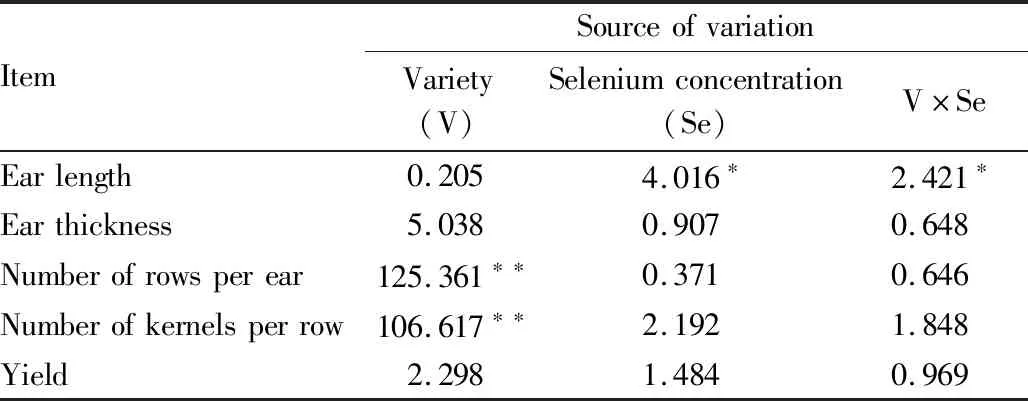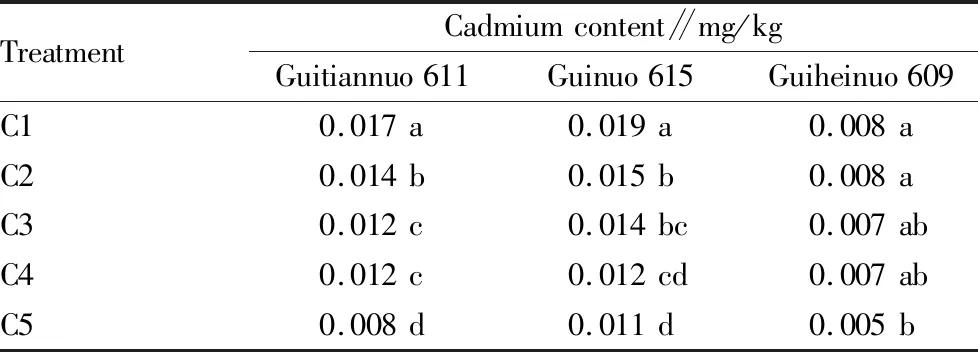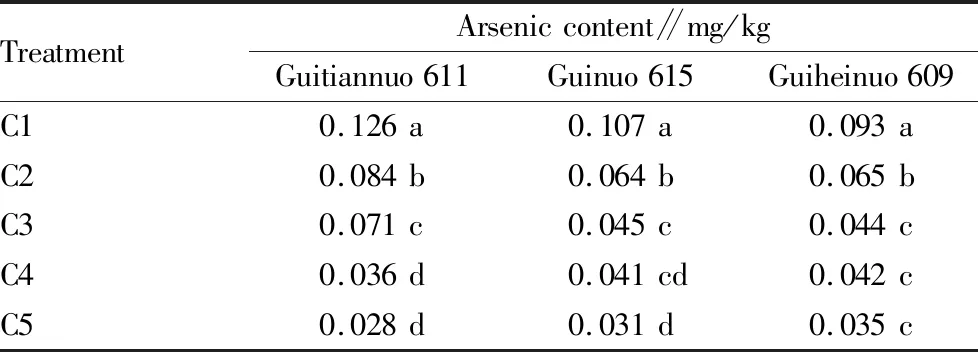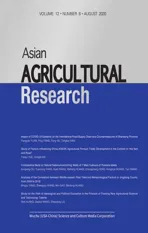Effect of Foliar Application of Selenium Fertilizer on Yield, Selenium Content and Heavy Metal Contents of Waxy Maize
2020-09-28ChenglinZOURuiningZHAIKaijianHUANGHuaTANDeboZHENGAihuaHUANGXinxingWEIRunxiuMOFaqianXIONGHuiWEIShanzhuWEI
Chenglin ZOU, Ruining ZHAI, Kaijian HUANG*, Hua TAN, Debo ZHENG, Aihua HUANG, Xinxing WEI, Runxiu MO, Faqian XIONG, Hui WEI, Shanzhu WEI
1. Maize Research Institute, Guangxi Academy of Agricultural Sciences, Nanning 530007, China; 2. Cash Crops Research Institute, Guangxi Academy of Agricultural Sciences, Nanning 530007, China
Abstract [Objectives] This study aimed to explore the effect of different concentrations of selenium fertilizer on the yield, selenium content and heavy metal contents of waxy maize, thereby providing reference for the scientific application of selenium fertilizer on waxy maize. [Methods] Different varieties of waxy maize (Guitiannuo 611, Guinuo 615 and Guiheinuo 609) were used as test materials. They were sprayed with different concentrations (0, 0.5, 1.0, 1.5 and 2.0 g/L) of water-soluble selenium fertilizer (Xinxibao) at the big flare stage, and the effect on the yield, selenium content and heavy metal contents of the waxy maize was analyzed. [Results] Foliar application of different concentrations of selenium fertilizer showed no significant effect on the yield and yield components of waxy maize. As the concentration of selenium fertilizer increased, the grain selenium content of different varieties of waxy maize increased. Among them, the increase of Guinuo 615 was the largest, of which the selenium content reached 0.265 mg/kg, 2.82 times that of the control (water). The cadmium and arsenic contents of different varieties of waxy maize decreased with the increase of the concentration of selenium fertilizer sprayed. Among the waxy maize varieties, the cadmium and arsenic contents of Guitiannuo 611 dropped the most significantly, up to 52.94% and 77.78%. In waxy maize, the correlation coefficients between selenium content and cadmium, arsenic contents were -0.550 9 (P<0.05) and -0.853 0 (P<0.01), respectively. [Conclusions] Spraying exogenous selenium fertilizer had no obvious effect on the yield of waxy maize. However, the increase of the concentration of exogenous selenium fertilizer could significantly increase the selenium content and reduce the cadmium and arsenic contents in grains of different varieties of waxy maize.
Key words Selenium fertilizer, Waxy maize, Yield, Selenium content, Heavy metal
1 Introduction
Selenium is one of the trace elements necessary to maintain the health of the human body. It has a variety of biological functions such as anti-oxidation, anti-cancer, and improving the body’s immunity[1-2]. Cadmium and arsenic are heavy metals, which are not essential elements for the human body, and there is a risk of poisoning if ingested for a long time. The above three elements are mainly enriched by plants and enter the human body through the food chain. Studies have shown that selenium can affect the growth and development of plants, and is involved in regulating photosynthesis and respiration of plants. The increase in selenium content can resist the damage of free radicals in plants, improve plant resistance to stress, and antagonize heavy metals,etc.[3]. Foliar application of selenium fertilizer is a convenient, safe and effective method to increase the selenium content of grain crops[4]. Waxy maize is a special type of fresh corn. Because of its unique taste and rich nutrition, it is loved by people. Especially in the southwest region, the planting area is large and there are many people who like to eat[5]. Therefore, studying the effect of foliar application of selenium fertilizer on waxy maize yield, selenium content and resistance to heavy metals such as cadmium and arsenic is of great significance to the stable, healthy and sustainable development of the waxy maize industry. There are many studies on crops’ selenium content and antagonism with heavy metals by adding exogenous selenium. He Qianfengetal.[6]studied the cadmium-reducing and selenium-enriching effect of different selenium-enriched foliar fertilizers on rice in lightly cadmium-polluted paddy fields. It is believed that spraying selenium-enriched foliar fertilizer can increase the yield and selenium content and reduce the cadmium content of rice. Huang Taiqingetal.[7]studied the effect of different selenium-containing foliar fertilizers on selenium enrichment and cadmium reduction in rice. The results show that in low-selenium and cadmium-slightly polluted rice fields, different formulas of selenium-containing foliar fertilizers have the effect of enriching selenium and reducing cadmium on polished rice. In the selenium-rich and cadmium-highly polluted rice fields, the cadmium content of polished rice treated with different formulas of selenium-containing foliar fertilizers was not significantly different from CK. The study by Kumaretal.[8]shows that selenium can reduce the arsenic content of rice roots and shoots. The research results of Liu Jinchang[9]show that selenium can inhibit the absorption and transport of arsenic in rice, and reduce arsenic content in rice roots and shoots. Feng Kuietal.[10]studied the effect of selenium application on the yield and grain selenium content of spring wheat at different densities, and determined the optimal planting density and selenium application rate for wheat. Chen Xi[11]analyzed the effect of selenium concentration on growth, heavy metal antagonism and element forms in vegetables, and believed that appropriate application of selenium fertilizer could reduce the impact of pollution on local vegetable planting. Liao Qingetal.[12]found that selenium application has a certain improving effect on the yield of fresh potatoes. There are also many reports on the selenium enrichment of maize. Zheng Yangetal.[5]revealed that different concentrations and different methods of selenium treatment significantly increased the selenium content of waxy maize kernels. At the same time, the starch, crude protein, crude fat, and soluble sugar contents all showed an increasing trend. The field yield increased slightly with the increase of selenium treatment concentration. Luo Lianguangetal.[13]used selenium-enriched phytonutrients for selenium-enriched maize cultivation experiment. The experimental results show that the selenium content of maize significantly increased, and the seed yield and 100-kernel weight increased by 16.09% and 28.7%, respectively compared with the water control. Huang Limeietal.[14]investigated the effect of foliar spraying of different concentrations of sodium selenite during tasseling stage on the grain selenium content, yield, nutritional quality and safety of Demeiya No.3, an ordinary maize variety. The results show that with the increase of exogenous selenium concentration, the selenium content, nutritional quality and safety of corn kernels were improved. Liu Chunjuetal.[15]found a positive correlation between the concentration of selenium fertilizer and the content of total selenium and organic selenium in fresh corn. There are many studies on the selenium content of maize. However, there are few studies on the effect of selenium on the heavy metal resistance of maize, especially fresh maize. In this study, different concentrations of selenium fertilizer were sprayed on leaves of different varieties of waxy maize to study their enrichment effect on exogenous selenium, and at the same time, the effect of selenium content on grain yield and heavy metal content of waxy maize was discussed, so as to provide reference for scientific application of selenium fertilizer in waxy maize.
2 Materials and methods
2.1 MaterialsThe tested varieties were the glutinous maize varieties Guitiannuo 611 (sweet-glutinous type), Guinuo 615 (ordinary glutinous type) and Guiheinuo 609 (black glutinous type) bred by the Maize Research Institute, Guangxi Academy of Agricultural Sciences. The experiment was carried out at Mingyang Base of Guangxi Academy of Agricultural Sciences from February to May of 2018. The selenium fertilizer used was water-soluble Xinxibao, purchased from Changsha Longnong Agricultural Technology Development Co., Ltd. The soil of the test site was latosolic red soil, with pH of 7.62, organic matter of 33.18 g/kg, alkali-hydrolyzable nitrogen of 212.15 mg/kg, available potassium of 169.25 mg/kg, organic phosphorus of 47.30 mg/kg, total selenium of 1.136 mg/g, total cadmium of 0.572 mg/kg and total arsenic of 23.057 mg/kg.
2.2 MethodsA two-factor split plot design was adopted with variety (Guitiannuo 611, Guinuo 615 and Guiheinuo 609) as the main pot and selenium fertilizer concentration [C1-C5, 0 (water), 0.5, 1.0, 1.5 and 2.0 g/L]as the split plot. There were four rows, 4.0 m in length, in each plot, with a row spacing of 0.7 m. The area of each plot was 11.2 m2. Three replicates were arranged for each treatment. The planting density was 51 000 plants/ha. At the big flare stage (11-12 unfolded leaves), selenium fertilizer solutions of different concentrations were prepared according to the design, and they were sprayed with a hand-held compression sprayer, at a dosage of 750 L/ha.
2.3 Measured items and methods
2.3.1Measurement of yield and related traits. In the late milk-ripe stage and early wax-ripe stage, the middle two rows of each plot were taken. After stripping the bracts, the yield of fresh ears was measured and converted into unit yield. At the same time, 10 representative ears were selected for testing, and the ear length, ear thickness, number of rows per ear and number of kernels per row were counted.
2.3.2Determination of selenium, cadmium and arsenic contents in grains. After measuring the yield, 3 ears were selected randomly from each plot. They were threshed, and prepared into solution by using a blender. The contents of selenium, cadmium and arsenic were determined according to GB 5009. 242-2007.
2.4 Statistics and analysisExcel 2003 was used for data statistics, and DPS16.05 was used for variance and correlation analysis.
3 Results and analysis
3.1 Effect of different varieties and different concentrations of selenium fertilizer on the yield and yield components of waxy maizeAs shown in Table 1, the effect of variety on ear length, ear thickness and yield of waxy maize was insignificant (P>0.05), and that on number of rows per ear and number of kernels per row was significant (P<0.05). The concentration of selenium fertilizer had a significant effect on ear length (P<0.05), and an insignificant effect on ear thickness, number of rows per ear, number of kernels per row and yield of waxy maize (P>0.05). The interaction between variety and selenium fertilizer concentration had a significant effect on ear length (P<0.05), and the effect on other indices was not significant (P>0.05).
Table 2 shows that the number of kernels per row of Guinuo 615 was smaller than that of Guitiannuo 611 and Guiheinuo 609 (P<0.05). The number of rows per ear and number of kernels per row had a little effect on the yield. The yield of the three varieties of waxy maize was in the order as Guitiannuo 611 > Guinuo 615 > Guiheinuo 609, and the differences among them were insignificant (P>0.05). With the increased concentration of selenium fertilizer, the ear length increased first and then decreased, and the ear length of each variety reached the maximum under the C3 treatment. The number of kernels per row in C3 treatment was significantly greater than those of C2 and C5 treatments, indicating that the concentration of selenium fertilizer had no obvious improving effect on the yield of waxy maize.

Table 1 F values of yield and its components of waxy maize under different treatments
3.2 Effect of different varieties and different concentrations of selenium fertilizer on the selenium content of waxy maizeThe results of the analysis of variance show that variety had no significant effect on the selenium content of grains (F=0.457); the effect of selenium fertilizer concentration on the selenium content of grains was significant (F=114.124**); and the interaction of the two factors showed a significant effect on the selenium content of grains (F=2.515*). Table 3 shows that the grain selenium content of different varieties of waxy maize increased with the increase of the sprayed selenium fertilizer concentration. The increase in grain selenium content of waxy maize varieties was not obvious under the C4 and C5 treatments. Compared with the control C1 (water), the grain selenium contents of the three waxy maize varieties all reached the maximum under the C5 treatment, 2-3 times the selenium content of the grains without application of selenium fertilizer. Among them, Guinuo 615 had the largest increase, reaching 2.82 times. Under the C5 treatment, the grain selenium content of Guinuo 615 was also greater than those of the other two varieties, showing that Guinuo 615 has a strong ability to accumulate exogenous selenium fertilizer.

Table 2 Yield and its components of waxy maize under different treatments

Table 3 Effect of different treatments on the grain selenium content of waxy maize
3.3 Effect of different varieties and different concentrations of selenium fertilizer on the cadmium content of waxy maize
The results of the analysis of variance show that the effect of variety on the grain cadmium content of waxy maize was significant (F=45.49*); and the concentration of selenium fertilizer had a significant effect on the grain cadmium content of waxy maize (F=15.94**). As the concentration of selenium fertilizer increased, the grain cadmium content of the three waxy maize varieties showed a downward trend. Guitiannuo 611 showed the most obvious downward trend. The grain cadmium content under the C5 treatment was 47.06% of that under the C1 treatment. The decrease in the grain cadmium content of Guinuo 615 ranked second, and the decrease of Guiheinuo 609 was the smallest. However, the grain cadmium content of Guiheinuo 609 was relatively under when selenium fertilizer was not sprayed (Table 4). Overall, Guinuo 615 absorbed the most cadmium, and Guiheinuo 609 absorbed the least cadmium. Foliar application of selenium fertilizer showed the most obvious reducing effect on the grain cadmium content of Guitiannuo 611.

Table 4 Effect of different treatment on the grain cadmium content of waxy maize
3.4 Effects of different varieties and different concentrations of selenium fertilizer on the arsenic content of waxy maizeThe results of the analysis of variance show that variety had a significant impact on the arsenic content of maize grains (F=17.35*), and the concentration of selenium fertilizer also had a significant effect on the arsenic content of maize grains (F=112.80**). As the concentration of sprayed selenium fertilizer increased, the grain arsenic content of the three waxy maize varieties showed a downward trend. Guitiannuo 611 showed the most obvious downward trend, and its grain arsenic content under the C5 treatment was 22.22% of that under the C1 treatment. The decline in grain arsenic content of Guinuo 615 ranked second, and the decline in the grain arsenic content of Guiheinuo 609 was the smallest. However, the grain arsenic content of Guiheinuo 609 was relatively low when selenium fertilizer was no sprayed (Table 5). Overall, Guitiannuo 611 absorbed the most arsenic, but its grain arsenic content declined most obviously after spraying selenium fertilizer. Under the C5 treatment, the grain arsenic content of Guitiannuo 611 was 0.028 mg/kg, lower than that of Guiheinuo 609.

Table 5 Effect of different treatments on the grain arsenic content of waxy maize
3.5 Correlation analysis between the concentration of selenium fertilizer sprayed on waxy maize and the contents of selenium, cadmium and arsenic in maize grains under different treatmentsTable 6 shows that the concentration of selenium fertilizer sprayed was positively correlated with the grain arsenic content (P<0.01), negatively correlated with grain cadmium content (P<0.05), and negatively correlated with grain arsenic content of waxy maize (P<0.01), suggesting that foliar application of selenium fertilizer had a significant effect on the selenium, cadmium and arsenic contents of waxy maize grains, and the effect on selenium and arsenic contents was particular significant. The selenium content was negatively correlated with cadmium (P<0.05) and arsenic contents (P<0.01), suggesting that the increase of selenium content could significantly reduce the contents of cadmium and arsenic in maize grains, and between them, the effect on arsenic content was more obvious.

Table 6 Correlation coefficients between concentration of selenium fertilizer and grain selenium, cadmium and arsenic contents of waxy maize
4 Discussion
Some studies[16-17]have shown that exogenous selenium fertilizer can increase crop yield, but some other studies[18-20]have also shown that exogenous selenium fertilizer has no effect on crop. The results of this study show that increasing the concentration of exogenous selenium fertilizer could slightly increase the yield of waxy maize. The increase did not reach a significant level, and the effect on most yield components also did not reach a significant level, indicating that although exogenous selenium fertilizer had a certain promoting effect on the growth of waxy maize, the effect was not obvious.
The effect of exogenous selenium fertilizer on crop yield is still inconclusive, but most scholars believe that it can increase the selenium content in crops[20-22]. The results of this study also show that as the concentration of selenium fertilizer sprayed increased, the grain selenium content of different varieties of waxy maize also increased. The size of the increase was related to the type of waxy maize varieties. The increase of Guinuo 615 was the greatest, and the selenium content was up to 0.265 mg/kg, 2.82 times that of the water control. The increase of Guiheinuo 609 was the smallest. Referring to the regulation in Rich Selenium Paddy (GB/T22499-2008), corn with selenium content of 0.040-0.300 mg/kg is selenium-rich corn. The three maize varieties already met the requirement of selenium-enrich maize when selenium fertilizer was not sprayed, consistent with the result that Jiang Cuiwenetal.[23]believed that the corn produced in Guangxi had a higher selenium content. However, excessive intake of selenium can cause diseases and can lead to selenium poisoning in the human body, and the symptoms involve skin, hair and nails[24]. Therefore, care should be taken when spraying exogenous selenium fertilizers to prevent excessive selenium content in corn.
Selenium has a strong bonding force with metals. Selenium can antagonize and weaken the toxicity of heavy metal elements such as arsenic, mercury, lead, chromium and cadmium in the body[25-26]. Many studies[27-28]have shown that the application of selenium fertilizer can produce a certain antagonistic effect on heavy metals in crops. The results of this study show that after spraying exogenous selenium fertilizer, the grain selenium content of different waxy maize varieties increased significantly, and at the same time, the grain cadmium and arsenic contents decreased significantly as the concentration of selenium fertilizer sprayed increased. The results of correlation analysis show that the selenium content was negatively correlated with the cadmium (P<0.05) and arsenic (P<0.01) content, respectively. It shows that selenium does have a certain antagonistic effect with cadmium and arsenic. The mechanism of action needs further study.
This study also found that different waxy maize varieties have different levels of cadmium and arsenic accumulation. Under the condition that exogenous selenium fertilizer was not sprayed, the cadmium and arsenic contents of Guiheinuo 609 were significantly lower than those of Guitiannuo 611 and Guinuo 615, which might be because that Guiheinuo 609 has natural resistance to cadmium and arsenic. However, its mechanism of action is still unclear, and further research is needed. With the increase of selenium fertilizer concentration, Guinuo 615 showed the most obvious reduction effect on cadmium and arsenic contents.
5 Conclusions
The effect of spraying exogenous selenium fertilizer on the yield of waxy maize is not obvious. The increase of the concentration of exogenous selenium fertilizer can significantly increase the selenium content of different waxy maize varieties, and reduce the cadmium and arsenic contents as well. As the waxy maize varieties of Guangxi have higher selenium content, when applying exogenous selenium fertilizer, the application amount should be carefully controlled to prevent the selenium content from exceeding the standard.
杂志排行
Asian Agricultural Research的其它文章
- Impact of COVID-19 Epidemic on the International Food Supply Chain and Countermeasures of Shandong Province
- Study of Factors Influencing China-ASEAN Agricultural Product Trade Development in the Context of "the Belt and Road"
- Comprehensive Evaluation on the Level of Agricultural Economic Development in Hubei Province Based on Principal Component Analysis
- Effects of Applying Trace Clements on Yield and Quality of Flue-cured Tobacco Cuibi-1
- Analysis of the Correlation between Middle-season Rice Yield and Meteorological Factors in Jingdong County from 2009 to 2016
- Successful Cultivation of Albino Mauremys mutica for the First Time
